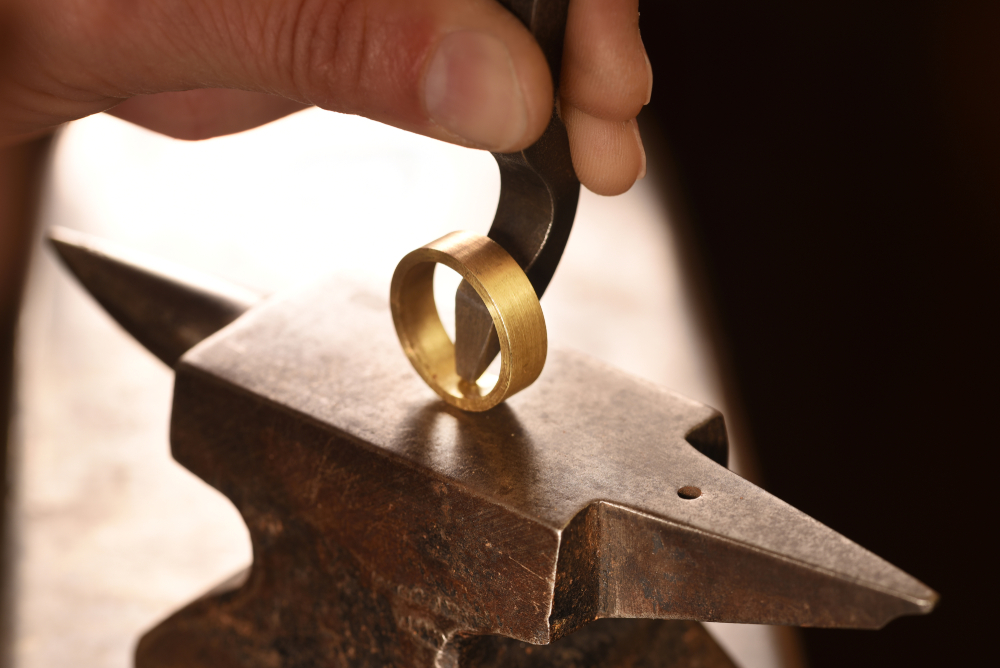Unfortunately, all that glitters is not gold, and if you read the press you’ll know that rogue jewellers exist even in the UK. For this reason, hallmarking is the first line of defence that consumers have against forged precious metal goods. We visited the London Assay Office where we have our own jewellery hallmarked, to bring you this guide with 10 things you need to know about hallmarking.
1. Hallmarking is the law in the UK
A hallmark is a UK Government seal that’s stamped onto precious metal objects, such as jewellery or silverware.
The purpose of a hallmark is to certify the metal purity of the item. In other words, if an object is stamped with a ‘gold’ hallmark, then you, the consumer, knowing that it is indeed real gold – and not something else that simply looks like gold.
Watch our video of hallmarking happening at the London Assay Office:
2. It’s an Official Stamp of Quality
The purpose of a hallmark is to certify the metal purity of the item, so you know what quality of gold, silver or platinum you are buying.
Testing precious metals for purity is called “assaying”. Therefore, the places where hallmarking is done are called Assay Offices. Only one of the four authorised UK Government Assay Offices can apply a hallmark, the official stamp of quality.
3. British hallmarking was established 700 years ago
The first Assay Office opened in London in 1327. This means that hallmarking is one of the earliest forms of consumer protection!
4. There are four UK assay offices
There are only four Assay Offices in Britain, located in London, Birmingham, Sheffield and Edinburgh.

5. There are four precious metals that require hallmarking
Gold, silver and platinum, and most recently, palladium, must all be hallmarked by UK law.
Gold (including all variations of it like white, yellow and rose gold) must be further hallmarked as 9K, 14K, 18K and 22K standards, and so on. Read more about the difference between gold karats here.
Silver, platinum and palladium must also satisfy a percentage of purity to meet UK hallmarking requirements.

6. Hallmarking protects both consumers and jewellers
Because it’s impossible to tell how pure a precious metal item is by simply looking at it, only official assaying can guarantee standards.
Compulsory hallmarking means that the public will always have a guarantee of genuine quality in their jewellery.
Likewise, the trade of legitimate jewellers is protected from unlawful competitors who might try to pass off lower quality jewellery as the “real deal”.
7. Today both modern & traditional assaying methods are used
Assay Office laboratories now test precious metal purity using the latest technologies, including x-ray and laser analysis. However, many objects are still stamped by hand, exactly as they were 700 years ago.

8. Only officially registered hallmarks can be used
Only jewellery that carries an officially registered British or international hallmark can be sold in the UK.
A hallmark will usually include the Assay Office town mark, together with 2-4 additional marks, such as a date letter, a metal standard symbol or a duty stamp.
There are hundreds of registered hallmark elements. If in doubt, contact the International Association of Assay Offices for more information.

9. The only exceptions to the hallmarking law are items that weight very little
The hallmarking law exempts precious metal objects that weigh under a certain number of grams. This could mean small jewellery items like stud earrings or pendants.
Jewellery does not have to be hallmarked if it weighs under:
10. It’s a criminal offence to misrepresent a hallmark
According to the Hallmarking Act, it’s an offence to claim that a piece of jewellery is made with gold, silver, platinum or palladium, unless it’s hallmarked as such. It’s also an offence to remove, alter, deface or counterfeit a hallmark.

